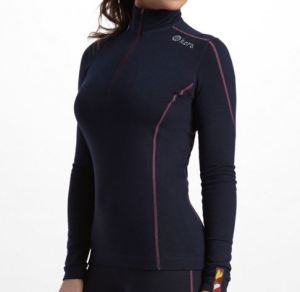Staying warm in cold weather conditions starts with having good baselayers. The importance of having high performance, technical clothing next to the skin can’t be overstated, as this is the part of your layering system that wicks moisture away from the body and helps to regulate temperature before adding an insulating and weather resistant layer as well.
Most baselayers today are made from technical fabrics or the wildly popular merino wool, which is a good choice because it is a material that is easy to obtain, and has natural wicking and odor-resistant properties. But, it turns out there are some other viable options for fabrics that can be used in creating clothing too, and some of them are even better suited to the job.
Kora baselayers utilize wool that is made from the hair of yaks that live in the High Himalaya. These animals have adapted over the centuries to the cold, windy, snowy climate found there, and as a result, they stay amazingly warm despite those conditions. It would seem logical than that their fur would be perfect for use in baselayers, right? That’s what the team at Kora thought as well.
I recently had the chance to put the Shola 230 Zip top to the test while visiting Quebec, Canada on a snowshoeing/dogsledding trip. While I was there, the temperatures dropped as low as -45ºF/-42ºC with the windchill. No matter how you slice it, that’s cold, and without a good layering system I would have been in big trouble. This top was the first thing I put on before adding the other layers, and after a few days of those deep-freeze conditions, I was certainly glad I had brought it along.
Kora says that yak wool is as much as 40% warmer than standard merino. I can’t speak to that number directly of course, but I can say that Shola 230 Zip is amazingly warm. I noticed a dramatic difference in performance between it and my other base layers that use merino wool instead, and when the temperature really started to plummet, I definitely preferred Kora’s offering over the competition.
The Shola top has a nice, athletic cut that helps it to mold to the body, just as you would expect from a good baselayer. You need it to fit closely in order to perform properly, otherwise your layering system won’t do its job as well as it should. And if the baselayer fails, you’re probably in for a long, cold day.
Just like merino wool, yak wool is very adept at wicking moisture away from the body. While snowshoeing up hill I managed to work up a sweat, even in the cold conditions. But thankfully, the Shola pulled that moisture away and dried very quickly, keeping me warmer as a result. And since yak wool shares the same antimicrobial properties as merino too, it doesn’t absorb odors. That’s important on a long trip when washing your gear isn’t a possibility.
One of the nice features of the Shola 230 Zip is that it is cut extra long. The garment drops down well below the waist, providing extra comfort and warmth to an area that is often quite literally left out in the cold. Most of our jackets and fleece layers reach below the waist, so why not our baselayers too? In the extreme cold of Quebec, I was glad to have an extra layer covering just about everywhere on my body.
This is a very versatile garment both as part of a layering system and on its own. While it is too warm to wear all of the time, I found it to be great for trail running, mountain biking, or hiking in colder weather. It is comfortable, form fitting, and doesn’t inhibit motion in anyway, and it also happens to look good too. That’s a pretty good combination for any piece of outdoor apparel.
The supply for yak wool isn’t quite so easy to come by as merino wool, which is raised in abundance throughout the world. This relative scarcity of the material is reflected somewhat in the price of Kora’s products. For instance, the Shola 230 has an MSRP of $160, which is well above much of the competition. That price is likely to turn off some people immediately, but in my opinion its performance warrants the additional costs. If you spend time in the outdoors during winter months and cold conditions are an issue, chances are you’ll feel the same way.
- Gear Review: The Xero Scrambler Mid is an Ultralight Hiking Shoe for Spring - March 1, 2023
- Gear Review: Yeti Roadie 48 Wheeled Cooler - August 18, 2022
- Kristin Harila Continues Pursuit of 8000-Meter Speed Record - August 16, 2022
